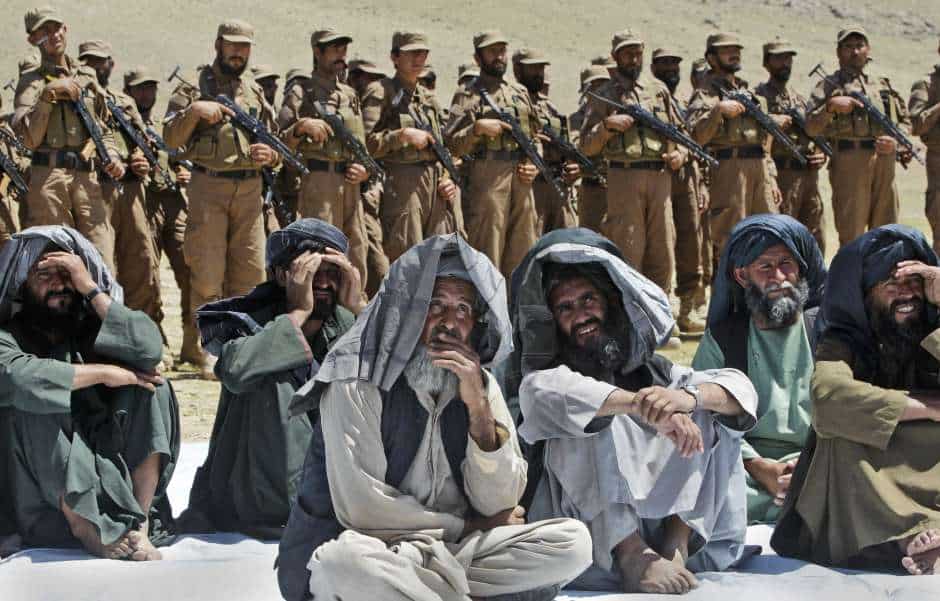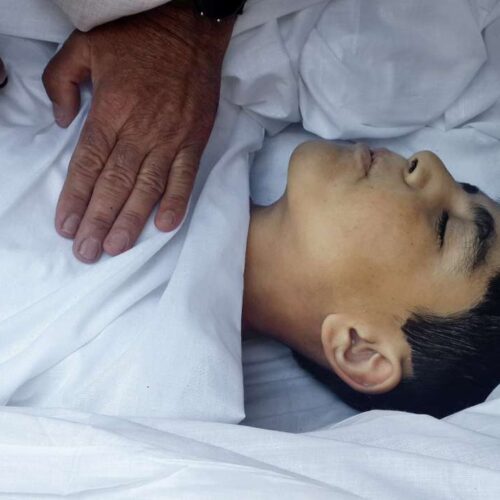This article was co-published with Foreign Policy magazine.
Introduction
Aug. 5, 2016: This article has been corrected.
Investigators for the United Nations found 48 child soldiers in Afghanistan last year, with more than one-fourth working for government-backed forces such as the Afghan National Army and the Afghan Local and National Police. But that news somehow never made an impact in Washington.
In an annual report released on June 30 that names 10 foreign countries known to use and recruit child soldiers, the State Department didn’t include Afghanistan — a country with forces labeled as “persistent perpetrators” by the United Nations in a report issued just two months earlier.
The discrepancy is partly a matter of legal interpretation but mostly one mired in international politics, it turns out.
Countries that employ child soldiers in their armed forces are barred from receiving specific types of U.S. military assistance or weapons, under a U.S. law enacted in 2008. But the Obama administration says Afghanistan is not subject to the law because its Local Police force — which uses child soldiers, and experts say operates like a militia or a paramilitary group — is not part of the armed forces.
This claim has allowed the U.S. Defense Department to give the Afghan Local Police a total of $470 million as of April 2015, according to a tally made by the Special Inspector General for Afghanistan Reconstruction. But nonprofit groups and independent experts on Afghanistan and the use of children in armed conflicts say the administration has misinterpreted the U.S. law or abused some ambiguities in its text.
“Not including Afghanistan sends out the message that children who have been recruited by police forces deserve less protection,” said Charu Lata Hogg, an associate fellow at the independent London-based institute Chatham House, who has worked extensively on the issue of child soldiers. “More children are likely to be recruited and used by militias than the military themselves.”
Even if the decision is not a violation of the law, it constitutes a breach of the “spirit of the law,” said Jo Becker, children’s rights advocacy director at the nonprofit organization Human Rights Watch in New York.
The law states that certain types of military assistance and armaments cannot flow to countries with “government-supported armed groups” that use child soldiers. It also makes clear that these groups include “paramilitaries, militias [and] civil defense forces.” The law does not explicitly mention police, however. Child soldiers are defined as those under the age of 18 who are recruited by such groups to work as soldiers or perform other tasks, including working as cooks or porters.

In 2015, Afghan President Ashraf Ghani signed a presidential decree criminalizing the recruitment of child soldiers, but the problem persists, experts say. The U.N. report, which included Afghanistan in a list of 14 countries that use and recruit child soldiers, noted that the number of verified cases last year was double that in 2014. It said the majority of the cases involved the Taliban and other armed groups, but five children were in the Local Police, five in the National Police, and three in the National Army.
“There is continuing concern about allegations of cross-border recruitment of children and of use of religious schools in Afghanistan and Pakistan for child recruitment and military training by the Taliban and other armed groups,” said the report, which was issued under Secretary General Ban Ki-moon’s name. “I am concerned … about the lack of oversight mechanisms for Afghan Local Police recruitment” involving children.
The State Department, in its annual human rights report for 2015, itself takes note of these and other “reports.” But when asked to explain why Afghanistan was not included on the U.S. list of nations with child soldiers, a State Department spokesman in the Bureau of Public Affairs, who said he could not be named, wrote in an email that “although the Afghan Local Police is a government security force, it falls outside of the armed forces of Afghanistan.” The spokesman also wrote that in the administration’s view, Afghanistan is taking useful steps to address the use and recruitment of child soldiers.
A somewhat different account of the Local Police’s role in armed conflict is given in Kabul. The Afghan Ministry of Interior Affairs, asked in an email if it should be considered part of the national government, said it is an “armed defense force” funded by the national government and that its purpose was to operate at the village level to “secure the insecure areas.”
Other documents make clear the force is not like police in Western nations: It does not investigate crime or arrest suspects. Its only function is instead to fight the insurgency, much like a militia. This is what NATO and the U.S. military state in a 112-page 2011 guide to the function and structure of Afghan police forces, labelled “for official use only” but posted online and confirmed as authentic by a NATO spokesman. The account is echoed in the Ministry of Interior Affairs’ 11-page procedural guide for the Afghan Local Police, prepared by four high ranking members of the Afghan Local Police and the nation’s Deputy Minister for Security in 2010.
The Afghan Local Police constitute an armed group because they “are engaging in conflict with other security groups against the Taliban,” said Becker, who investigates the use and recruitment of child soldiers by armed forces around the world. Therefore, “Afghanistan belongs on the list,” she says.
Experts note that a 10-year-old member of the Afghan Local Police, Wasil Ahmad, became famous in the region after fighting the Taliban in 2015; he clutched a machine gun to his chest in photos taken before he was killed by insurgents earlier this year. As recently as last October, a 17-year-old member of the Afghan National Police told the London-based advocacy group Child Soldiers International that at the age of 15 or 16 he used a false identification card to register for the force, according to the advocacy group’s March 2016 report on Afghanistan. He said the only person who questioned his age was the doctor who completed the medical examination. The boy also told them he met roughly 15 kids younger than him at police training in Kabul.

One of the drafters of the 2008 law, Sen. Richard Durbin, D-Ill., said in an email that in his view “the use of child soldiers is unacceptable in any nation’s military, and the United States has an added responsibility to help eradicate the practice in countries where we are engaged.” In Afghanistan, he said, there does “seem to be a greater problem in the Afghan police forces” than in the military. But he also said the law’s provisions do not cover police, highlighting what he considers a loophole that “warrants a closer look.”
Congress already amended the law once before, Durbin wrote, and it can do so again. He was referring to a change made in 2013 to amend the law to prohibit providing peacekeeping funding for countries with child soldiers, a type of aid that had not originally been included in the law. This occurred after the U.S. listed Somalia — a country that has long employed child soldiers — but continued sending military aid through peacekeeping accounts.
Ironically, even if the provisions of the law were drawn tightly enough to cover all the foreign forces that might employ child soldiers, the president still has the authority to exempt countries from the funding ban, keeping aid going if needed for U.S. national security — a waiver that Obama issued last year for the Democratic Republic of the Congo (DRC), Nigeria, Somalia, and South Sudan.
In the Congo alone, U.N. investigators verified the recruitment of 488 children in 2015 by 12 different governmental and non-governmental armed groups. In some cases in the DRC, children were abducted from their homes, according to Marie de la Soudière, an expert consultant who led Child Soldiers International’s field work in the country. The United States authorized roughly $14 million in peacekeeping funds for the DRC for 2016.
In Nigeria, children manned checkpoints and operated as spies in a government militia, known as the Civilian Joint Task Force, according to the U.N.’s report. In Somalia, the army recruited 218 children; in South Sudan, U.N. investigators said they saw children wearing military outfits throughout the country. Many children engaged in direct conflict.
Afghanistan is not the only country that the United States omits. Unlike the U.S. list, the U.N. list of nations with child soldiers includes Colombia, the Central African Republic, the Philippines and Mali. The U.N. has a more comprehensive definition for countries on the list; it includes all governmental and non-governmental armed groups that use and recruit child soldiers in each nation — including police. But while the U.N. list has remained relatively stable since 2010 at roughly 14 countries the U.S. list has grown from six countries in 2010 to 10 countries in 2016.
This dismal trend has generally not, however, impeded U.S. foreign aid to the problem countries, despite the ambition of the 2008 law’s drafters to use such aid as a cudgel to force improved behavior.
The Obama administration has authorized over $100 million in peacekeeping funds for Somalia and roughly $30 million for South Sudan for 2016 alone, according to estimates provided by the Stimson Center, a nonprofit Washington-based global security think tank. Overall, it withheld just 5.8 percent of roughly $1 billion in military assistance and 1.7 percent of over $300 million worth of arms sales from 12 countries that have been identified on the U.S. child soldiers list since 2010, according to Stimson’s analysis of funds subject to the law. In that same period, the administration authorized at least $7.8 billion in military assistance and arms sales for Afghanistan that would have been prohibited by the child soldiers’ law.
Experts say that putting countries onto the “child soldier list” sometimes has useful consequences. After the United States put Chad on the list in 2010, 2011, and 2013, the government signed an action plan with the United Nations in 2011 to address the issue; by 2014, the U.N.’s own list of groups that use and recruit child soldiers no longer included Chad.
Leaving Afghanistan off the U.S. list of nations that employ child soldiers — even if it subsequently gets a waiver — gives others “a clear roadmap [to] get around the law,” says Jesse Eaves, who works with the U.S.-based foundation Humanity United on issues related to human trafficking. “These countries can just change the name of their armed forces … and not even get lsted. It’s just a blatant runaround of what the law was intended to do.”
Lauren Chadwick is a Scoville Fellow at the Center.
Correction, Aug. 5, 2016, 2:51 p.m.: An earlier version of this story incorrectly stated that more than half of the child soldiers verified by the United Nations worked for government-backed forces in Afghanistan. Over one-fourth worked for government-backed forces.
Read more in National Security
Up in Arms
Deadly pathogens repeatedly dispatched by U.S. labs to unsecure sites
The government isn’t regulating how highly dangerous viruses and bacteria are rendered safe for shipment, posing risks to the public, auditors say
National Security
A secret group easily bought the raw ingredients for a dirty bomb – here in America
An undercover congressional operation exposes gaps in U.S. regulations and undermines Washington’s claim to be the best in the world at blocking this potential terrorist threat


Join the conversation
Show Comments